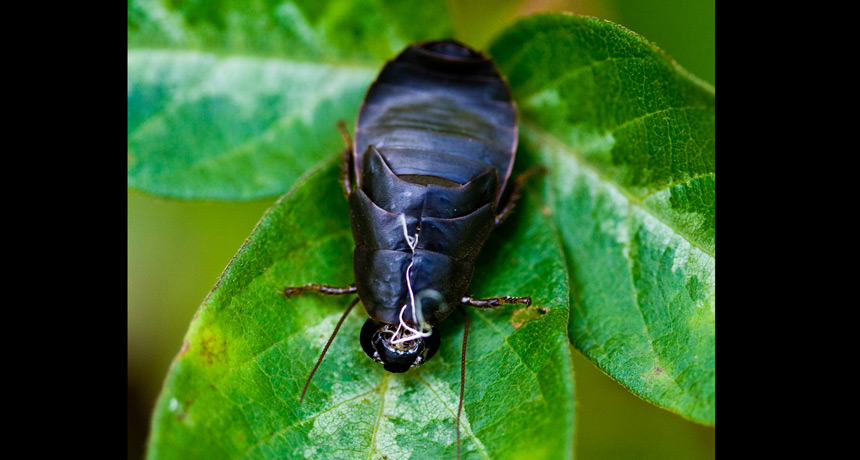Got milk? Roach milk could be a new superfood
Scientists find nutritious 'milk' inside one type of cockroach

This is the molted shell of the Pacific beetle cockroach, left behind on a Hawaiian leaf. Mother’s 'milk' from this insect is three times more nutritious than cow’s milk, new data show.
Ken-ichi Ueda/ Flickr (CC BY-NC 2.0)
By Dinsa Sachan
Many people don’t consider their breakfast complete without a glass of milk. Right now, cows, buffaloes, goats and sheep provide most of the world’s milk. But soon, people could be sipping milk from cockroaches. At least, that’s what an international group of scientists is proposing.
That’s not as crazy as it might sound. New research shows this “milk” is super-nutritious. What’s more, some scientists have already begun referring to many insects as mini-livestock.
In 2004, Subramanian Ramaswamy started studying crystals that are found inside the guts of cockroach embryos. At the time, he was teaching biochemistry at the University of Iowa in Iowa City. (Now Ramaswamy studies a host of topics — including infectious diseases — at the Institute for Stem Cell Science and Regenerative Medicine. It’s in Bangalore, India.)
The crystals had come from the Pacific beetle cockroach. This is the only cockroach species that’s viviparous (Vy-VIP-er-us). That means it gives birth to live young. The cockroach mothers feed the babies growing inside them with a milk-like liquid. That milk contains the crystals, which are made of protein.
To learn more about these milk crystals, the scientists needed to study them up close. “To see an object, you will throw light on it,” Ramaswamy says. “To look at atoms or molecules, you’d want to use wavelengths of [light] that are smaller than the distances between atoms and molecules.” X-rays are a form of light, he explains. And their wavelengths are the right size to see atoms in a crystal of some protein.
The atoms in the crystal will cause any x-rays beamed at it to scatter somewhat. That’s why this scanning technique is known as x-ray diffraction. And the scatter pattern that emerges helps scientists map the placement of those atoms making up the crystal’s structure.
The scanning data basically revealed the chemical recipe of the cockroach crystal. They showed that cockroach milk is a “complete food.” It contains sugar with a fatty acid stuck to it. (Fatty acids are the building blocks of fats). The protein in the milk is also chock full of essential amino acids. Amino acids are the building blocks of proteins. Since our bodies can’t manufacture the “essential” ones, we need to get them from our food. And so do baby cockroaches.
Barbara Stay also worked on the new study. She’s a biologist at the University of Iowa. She says the new data show that the roach milk is “three times more nutritious than cow’s milk and four times more nutritious than buffalo’s milk.” That would make it a very rich source of body-building ingredients.
The team’s findings appear in the July issue of IUCrJ. It’s a journal put out by the International Union of Crystallography.
Ramaswamy would like to see cockroach milk turned into a protein supplement to feed hungry people. But not everyone is confident it can be done.
Marcel Dicke studies insects as a potential source of human food at the Wageningen University in the Netherlands. Dicke says this is a “sound study.” But he believes it would be difficult to extract milk from cockroaches on a large scale, like we do with cattle. In his opinion, “it can only likely be done in a destructive way with only minute quantities.” That means you would have to raise — and kill — a lot of bugs to get even tiny quantities of the milk.
Another possibility would be to make this milk on a large scale in vats using yeast. Biotechnologists use yeast to make a number of products, including medicines. They do this by adding new genes to yeast microbes. In this case, they would add the genes that the cockroach uses to make its milk protein.
Yet for now, even Ramaswamy admits that industrial production of this milk “is wishful thinking.” That is, if what you’re wishing for is a cold glass of cockroach milk.







